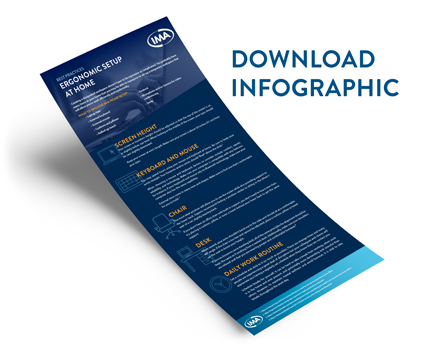COVID-19
Ergonomic Setup at Home
Creating a designated workspace doesn’t have to be expensive or complicated. How to set up your work from home office so that you can thrive.
Ergonomic Setup At Home
Creating a designated workspace doesn’t have to be expensive or complicated. You probably have many items in your home that you may be able to repurpose to set-up a temporary workspace that will allow you to work efficiently and comfortably.
What to include in a home setup[1]
- Laptop riser
- External keyboard
- External mouse
- Cushions and pillows
- Rolled-up towel
- Footrest
- Microphone and/or Camera for video conferencing
- Lamp
Screen Height
Your screen or monitor’s height should be adjusted so that the top of the screen is at, or slightly below, eye level. When looking at the middle of the screen, your eyes should be cast slightly downward.
Keep your screen at arm’s length: Make sure your screen is about 20 inches (51 cm) from your eyes.
Keyboard and Mouse
You may spend hours using your mouse and keyboard at home. Be sure to keep your wrists straight. Your forearms and/or wrists should “float” above the desk.[2]
When choosing a mouse and keyboard, factors to consider include comfort, speed, reliability, and technology. Make sure your computer is compatible with any features, for instance, if your keyboard and mouse rely on Bluetooth technology, make sure your computer also has the same capability.
External mice come in many sizes and shapes. Make sure to find one that’s comfortable for you to hold. [3]
Chair
The most ideal position will allow you to see the screen while also providing support to the lower back. Experts recommend finding a position similar to sitting in the driver’s seat of a car, slightly leaning back.
If you don’t have an office chair with built in support, you don’t need to buy a new chair, try placing a cushion, pillow, or even a towel behind your lower back to get the same support.
Desk
When seated, your arms shouldn’t bend out to the sides and should sit at a comfortable 90° angle. If the chair is too low and cannot be adjusted, place a cushion, pillow or towel on the seat to boost your height.
If you’ve chosen to use a standing desk, all of the same principles for alignment should be kept, the same as if working from a seated-desk. Additionally, make sure your shoulders are relaxed and that you are wearing proper and comfortable footwear.[4]
Daily Work Routine
Set a schedule and stick to it (as much as possible.) These are strange times and many people are experiencing a great deal of disruption but your colleagues and clients will appreciate you having a regularly set schedule when they know they can contact you.
Schedule breaks for yourself. It can be hard to take a break from working, when work is in the home and ever present, and potentially more demanding and stressful than others. However, to maintain mental wellness and avoid burnout, it is vital to take breaks throughout the work day.
1. https://www.pcmag.com/how-to/everything-you-need-to-set-up-an-ergonomic-home-office
2. http://ergonomictrends.com/proper-ergonomic-typing-posture-at-computer/
3. https://www.techradar.com/news/working-from-home-everything-you-need-to-set-up-your-new-home-office
4. https://www.standstand.com/2017/03/best-practices-for-using-a-standing-desk
